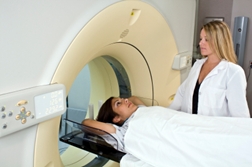 Gadolinium is a clear, non-radioactive chemical compound used with patients undergoing magnetic resonance imaging (MRI) and magnetic resonance angiography (MRA). Doctors say the MRI contrast agent is part of an essential toolbox to save lives and that it is safe. But a number of MRI lawsuits filed against gadolinium manufacturers say otherwise.
Gadolinium is a clear, non-radioactive chemical compound used with patients undergoing magnetic resonance imaging (MRI) and magnetic resonance angiography (MRA). Doctors say the MRI contrast agent is part of an essential toolbox to save lives and that it is safe. But a number of MRI lawsuits filed against gadolinium manufacturers say otherwise.For instance, the actor and martial artist Chuck Norris has another fight on his hands—this time with companies who make gadolinium-based products. His wife Gena is suffering from Gadolinium Deposition Disease (GDD) after undergoing three contrast-enhanced MRIs in a one-week period. The "Gadolinium in Humans" paper from the American Journal of Radiology says that Gadolinium Storage Condition is the excess of gadolinium in patients with normal renal function, and Gadolinium Deposition Disease occurs when a patient has an excess of gadolinium in their system, but they have normal or adequate renal function.
According to Dr. Richard Semelka, Gadoliniumn Deposition Disease (GDD) symptoms must start within minutes to one month after administration of a gadolinium-based contrast agent (GBCA). Second, the symptoms experienced by the patient after GBCA administration must be new, and not preexisting. There are now six symptoms (below) that are critical diagnostic findings for GDD, states Dr. Semelka. One of those symptoms is head pain.
“I had my first MRI last October. Two weeks later the headaches started and wouldn’t go away,” says Virginia. “They started around noon every day and got progressively worse. I’ve never had headaches like this before and they lasted for months. Then they just stopped, right out of the blue. They stopped as strangely as they started, but my shoulder and arm pain is still there.”
“I had problems with my shoulder and arm in the past, so I don’t know if it is linked to the MRI,” Virginia adds. “Physiotherapy helps but nothing helped the headaches, and I am sure that is related; these head pains were too coincidental. They went away but my gadolinium concerns are still here. I don’t know enough about it, and I don’t think the medical profession does either."
The Journal of Clinical Pharmacology (Nov 2018) published a study saying that, Although the development of nephrogenic systemic fibrosis in patients with renal impairment is well-documented, over recent years it has become apparent that exposure to GBCAs can potentially result in gadolinium deposition within human bone and brain tissue even in the presence of normal renal function. Approximately 30 million magnetic resonance imaging scans are enhanced with gadolinium-based contrast agents (GBCAs) worldwide.
Virginia had this first MRI with contrast dye for breast cancer. The second scheduled MRI was to detect endometrial cancer.
“From what I understand now, once gadolinium is in your body, it stays in your body and that concerns me. I was worried so I called the hospital ahead of time and asked if I was going to get the dye,” says Virginia. “The technician said I didn’t need it so I didn’t have to arrive 90 minutes early. When I got there, however, the radiologist said I was 90 minutes late and that I was supposed to have the contrast agent – it takes 90 minutes to get into your system. Then he said, ‘We’ll just go ahead without it.’ And that worked for me.”
Virginia’s MRI did show a benign lump and it found fibroids–without using the MRI contrast dye. “I am so done with this gadolinium,” Virginia says. “As it turns out, and this is good for your LawyersandSettlements readers to know, I didn’t even need the contrast agent with this second MRI!”
The 6 main clinical criteria for Gadolinium Deposition Disease, according to Dr. Semelka are:
1. Intense burning of the skin and skin substrate. Arising in early stage (early on after GBCA): This can be an all over feeling in the body, but often may be localized to the trunk region or distal extremities.
2. Intense boring pain in bones or joints. Arising in early stage (early on after GBCA): This can be any bones or any joints. Often the joints may be peripheral but can also be large joints like the knee or hip. Any bones can have severe point pain, but rib pain is quite distinctive for the disease.
3. Brain fog. Arising in early stage (early on after GBCA): Many terms have been used for this: mental confusion sounds more scientific, but brain fog gets the point across well and succinctly. Brain fog is also a prominent feature of lead toxicity, which is another heavy metal toxicity.
4. Muscle vibrations (muscle fasciculations) and skin pins and needles/tingling (early on after GBCA). These symptoms may represent part of the same process that is causing brain fog. Muscle vibrations/twitching and pins and needles skin sensations generally reflect nerve disease (neuropathy).
READ MORE MRI HEALTH RISK LEGAL NEWS
6. Distal arm and leg skin/skin substrate thickening, discoloration, and pain. Arising in the subacute stage (2 weeks +): This is very much like the principal features of NSF, but generally less severe. Instead of woodiness, doughiness; instead of redness, pinkness; instead of extreme joint contractures, stiffness of joints and decreased range of motion. Skin tightness is a feature of GDD as well. This symptom complex should be expected.

READER COMMENTS
kendall lewis
on
Crystal Anderson
on
How many people have been given chronic illnesses including fibromyalgia, chronic fatigue, Lupus, Sclerosing diseases and don’t even know that they were permanently poisoned by western medicine complex?
Emma L. Beaman
on
JERRY RACHELS
on